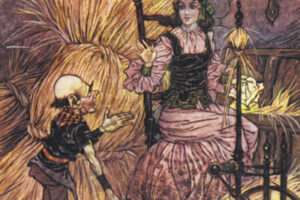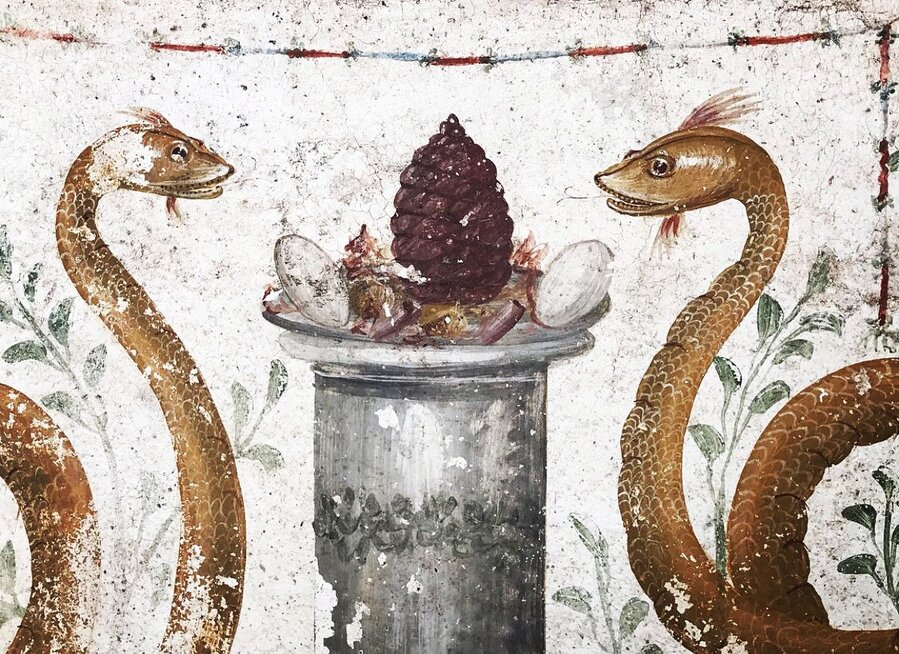
The Italic snake cult
The Italic snake cult
by Hasan Andrea Abou Saida
Snake-based beliefs and myths have always been attested throughout the Italian peninsula, and their origin dates back to the religiosity and cults of the ancient Italic peoples. The serpent of ancient Europe, a manifestation of the Great Mother, symbolised life force and transformation, and was intimately connected with feminine power, the waters and the Moon. According to studies by Lithuanian archaeologist Marija Gimbutas, the symbols surrounding the snake and the anthropomorphic Goddess Snake are identical to those associated with the water bird and the Bird Goddess found in the Neolithic and Palaeolithic periods. Her seasonal renewal, with the changing of her old skin and hibernation, are the manifestation of the archetype of the continuity of life and the existence of the afterlife. The serpent of Old Europe was therefore a manifestation of the primordial Great Mother, through her divine attributes related to fertility, transformation and life energy. Effigies representing the serpent are known throughout Europe since the Upper Palaeolithic and continued into the Mesolithic and Neolithic. In the Neolithic period of 6500 – 5500 BC, snake heads with round eyes and elongated mouths are carved or emphasised on jars in southern and south-eastern Europe, continuing to be a primary figurative element for centuries 1. Images of serpentine female divinities are also found in Italy in the frescoes in the Porto Badisco cave in Apulia, on whose walls mysterious creatures are painted in black, their limbs ending in snake spirals 2. In Scaloria, in the area of Manfredonia, more than 1500 vases have been discovered, dating from 5600 – 5300 BC, decorated with egg, plant, snake, triangle, hourglass, V or chevron motifs, probably related to the Mysteries of Death and Regeneration that were performed in the cave 3.
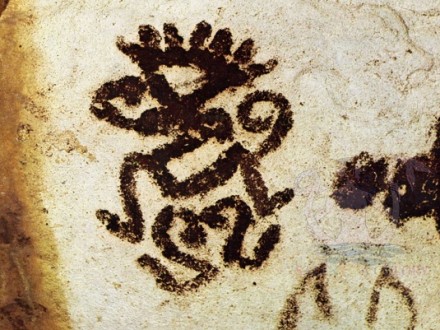
The divine feminine manifestations of the snake were also present in the Italic peoples settled in central-northern Italy around the 1st millennium BC, in the archaic cult of the goddess Angizia. Sister goddess of the sorceress Circe and Medea, she was one of the main deities worshipped by the Marsi, the Peligni and other Osco-Umbrian peoples, associated above all with the cult of snakes. The same name of the divinity is found as Anguitia (anguis: water snake in Latin), or with the name Ancaria or Ancheria, worshipped by the Piceni, particularly in the areas of Ascoli, Osimo and Pesaro, or also called Vanth by the Etruscans. With chthonic characteristics, she was for these peoples a true Great Mother, Earth Goddess and Nature Goddess, and was worshipped in vast areas of central-southern Italy, where she was honoured through ceremonies and fertility rites held in mid-spring. The ancient priestesses of the goddess Angizia knew how to make medicines from both herbs and snake venom, giving her the status of Dea Salus, goddess of healing.Her cult was aimed exclusively at women, to whom she taught the magical and healing arts. The Marsi considered her to be a sorceress, and sometimes even a fairy, and attributed many powers to her, such as that of killing snakes with a single touch. The sacred grove that Virgil said was dedicated to the goddess Angizia is located near the archaeological site of Lucus Angitiae on the outskirts of present-day Luco dei Marsi, where, according to some authors, ierodulia, or sacred prostitution, was practised in the sanctuary 4.
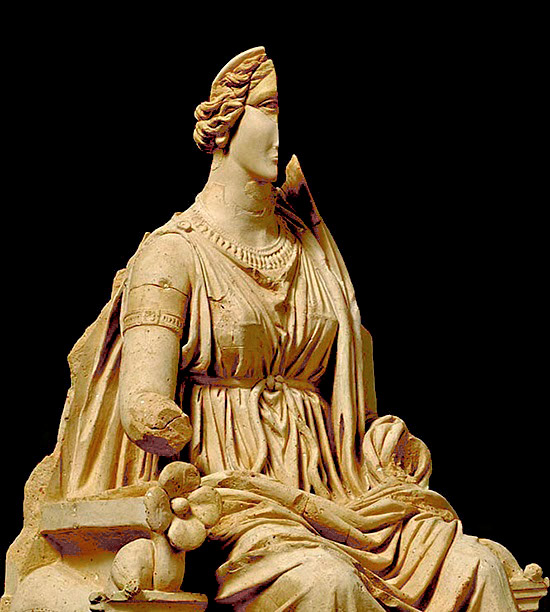
In the Greek world, the female deities linked to the cult of the serpent, and especially to the archetype of the healer sorceress, were Circe and Medea. Both were women of a semi-divine nature and experts in the knowledge of herbs and the preparation of medicines, poisons and magic potions. The connection between Medea and the serpent/dragon and between Circe, Angizia’s sister, and the water/moon world (she lives alone on an island) leads us to suppose that originally both women were a continuation of the archaic figure of Ptonia Theron, ‘Lady of the Animals’, or also called Ptonia Ophiòn, or ‘Lady of the Snakes’ 5.
Another Greek deity connected with the power of the serpent was Hygieia, daughter of Asclepius. Goddess of healing and health, she is represented as a young woman caught in the coils of the reptile. The very name of the goddess (from the Greek Ὑγίεια) has the meaning of “health”, “remedy”, “medicine” 6. Famous among Greek legends is the gorgon Medusa, a half-woman, half-reptile being with a head encircled by snakes, boar’s tusks, bronze hands, golden wings, glittering eyes and a gaze that petrifies 7.
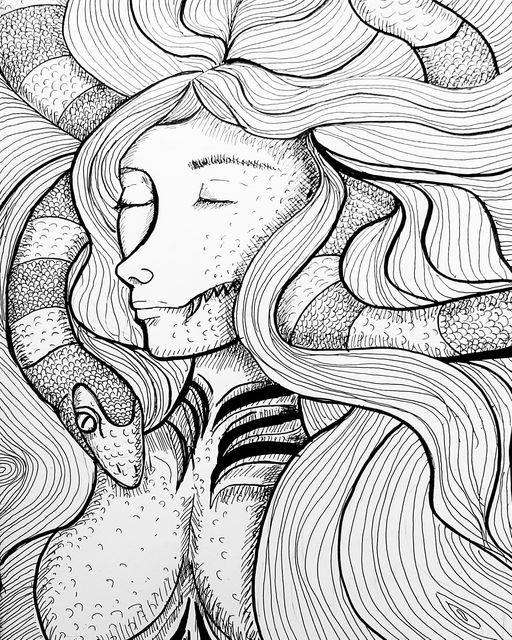
Also in Rome and all over Latium there were several serpentine cults, such as that of Juno Sospita in Lanuvio and that of Bona Dea on the Aventine. The first one was very similar to the Delphic one, where Juno was represented by a large snake living in a cave, and in spring virgin maidens offered him a cake to propitiate a good coming harvest. Juno Lanuviva or Sispes or Sospita was a chthonic deity linked to the cycle of the seasons and the return of blossom. The sacred serpent of the goddess is said to have been kept in the basement of her temple. The second Roman cult was dedicated to Bona Dea, another very ancient telluric deity also linked to vegetation and female mystery cults, whose priestesses apparently united sexually with the snake to evoke an ancient legend narrated by Macrobius, in which Bona Dea unites with Faunus in the guise of a snake. The real name of the Bona Dea, which could never be pronounced, was Fauna, wife of Faunus 8.
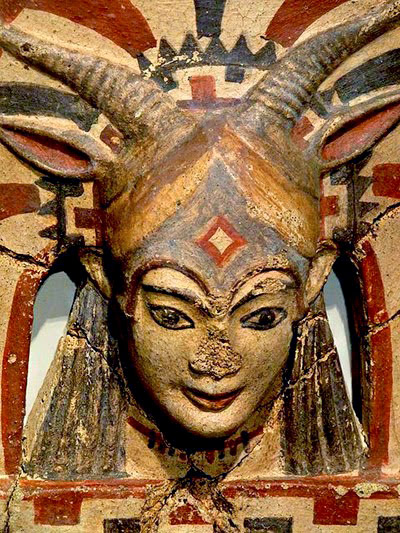
The snake was also the most frequent representation on the Latin lararia, the places where the genius pater familiaris and the Lares or tutelary deities of the family were worshipped. The Lares (from the Latin lares, meaning ‘hearth’) were the protective spirits of deceased ancestors who watched over the welfare of the family, the home and the hearth. The snake became the incarnation of the ancestor’s soul, as a chthonic animal connected to the underworld and the depths of the Earth. At Herculaneum, a sacellum surrounded by a serpent with the inscription “genius of this place, of the mountain” (genius huius locis montis) is still clearly visible on a painted wall. In the Roman conception of the sacred, the Genius entities not only protected individuals, families and people, but also private places, mountains, woods, springs and cities: just as there was a Genius guardian of the Roman people (Genius Publicus Populi Romani Quiritium) there was, for example, a Genius of the place where Rome was founded (Genius Urbis Romae). The snake therefore represented the tutelary deity of the place where the house stood and acted as the guardian of the domus, also in a purely physical sense. This explains, for example, why the theme of the snake (or snakes) is also frequently found on the outside walls of houses in Pompeii or in the aedicules of the compita, i.e. the crossroads or intersections where the Lari Compitales, the deities protecting the places where the roads crossed, were honoured. Inside a private house, the presence of one or two snakes on a wall that housed the lararium had the precise purpose of reminding all those who entered the room that this part of the building was intended for sacred purposes and should therefore be respected. In a famous passage by Aulus Gellius, the antiquarian recalls how the mother of the future leader Publius Scipio Africanus despaired of having children, until one night a snake entered her room and bed, and then immediately left. Shortly afterwards, the woman began to show the first signs of pregnancy. The benign genius loci had granted his wishes. In many parts of Italy (and Europe) the snake was bred and fed at home, as if it were a relative, and could not be killed without endangering the lives of its owners 9.
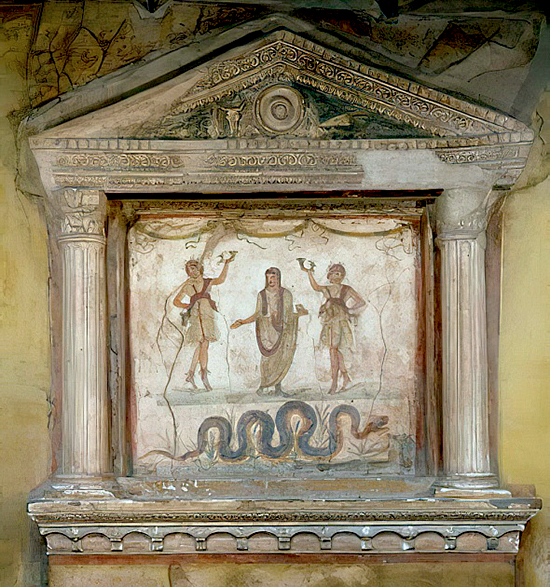
The cultural traditions and partially Christianised festivals linked to the snake, heirs of ancient pagan and Italic cults, are still present and alive throughout the Italian peninsula, such as the festival of St. Dominic in Latium, Abruzzo and Umbria (Foligno, Orvieto, Leonessa, Villamagna, Pretoro, Cocullo, Anversa degli Abruzzi, Villalago, Pizzoferrato, Guardiagrerato, Guardiagrecia). Domenico in Lazio, Abruzzo and Umbria (Foligno, Orvieto, Leonessa, Villamagna, Pretoro, Cocullo, Anversa degli Abruzzi, Villalago, Pizzoferrato, Guardiagrele, Palombaro, Castelmassimo, Sora), the feast of St. Vito di Leonessa in Rieti and the feast of St. Cristina in Bolsena. In the village of Cocullo, the first Thursday in May is the feast of the Serpari, dedicated to St Dominic, an ancient celebration derived from the rites of the Marsi and the pagan cult of Angizia. According to a local tradition, the saint, by removing his tooth and giving it to the population, gave rise to a faith that supplanted the pagan cult of the goddess Angizia, protector of poisons, including snakes. At the beginning of spring, snakes were offered to this goddess as propitiatory acts. The tooth of St Dominic is a probable allusion to the snake’s poisoning tooth. The first phase of the festival dedicated to the saint takes place months earlier and consists of the search and capture of snakes (all strictly non-poisonous) by experts, known locally as ‘serpari’, who observe the same techniques as their ancestors. The ‘Serparo’ is the main figure in the ritual. From the early hours of the morning, they walk around the town square with various types of snakes and invite the people present to make contact with the reptile in order to overcome the fear and revulsion that the animal instils. At midday, the procession begins with the statue of the saint wrapped in snakes, which are placed there by the serpents. Depending on how the snakes wrap around the statue, the people of Coculle draw good or bad omens for the future 10.
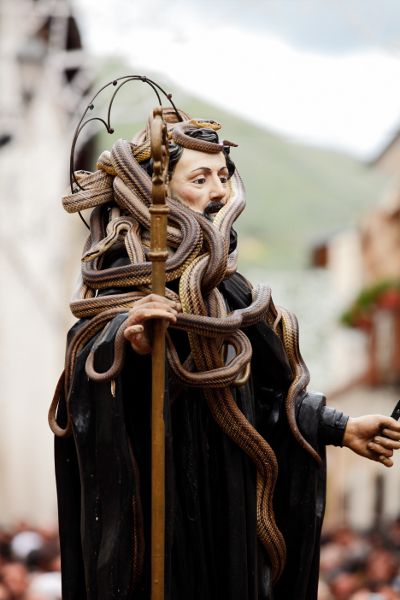
The rite of Saint Dominic is very popular and is also practised in the Abruzzi villages of Palombaro and Pretoro, on the first Sunday in May. Saint Dominic is the patron saint of the latter village, and a theatrical pantomime is celebrated with local actors, who stage another of the saint’s hagiographic miracles in a wood, namely the liberation of a child from the jaws of a wolf. The story tells of a young couple of woodcutters who go into the mountains with their little son, just a few months old. While they are busy working, a wolf comes out of the bush and kidnaps the baby from its unattended cradle. The parents, fearing for the fate of their baby, call upon the saint, who intervenes to tame the animal and have him bring the child back safe and sound. In this particular festival, the initiatory power of St Dominic is expressed along with the meteorological and thaumaturgical aspects through contact with the rocks. As well as healing from snake bites, St Dominic keeps earthquakes away, just like the ancient chthonic serpentine gods 11.

Other festivals with a chthonian-Serpentine character can also be found in the Marsica and Fucino basins, and in the towns of Atessa and Pacentro, typically seismic areas, where ancient telluric cults took place. In Atessa, there is still a very strong cult dedicated to St Martin of Mondragone, a hermit and follower of St Benedict. The feast of the saint takes place on 3 August and is celebrated with the typical “procession of the ‘ndorce” (torches made of virgin beeswax) characterised by propitiatory gestures made with stones, which are taken from the fields to cure colic, or by rubbing rituals on the rocks, again for therapeutic and propitiatory purposes. Closer to the orgiastic cults of propitiation is the legend that St Martin, who died in a barrel, gave it the power to gush out wine ad infinitum. St Martin therefore presides over the Earth’s renewal and fertility cults, with the same attributes as the serpent/dragon. In popular tradition and folklore, thunder, earthquakes and snakes are closely linked 12. A proverb from Pescina in Abruzzo says ‘If it thunders on the first Friday in March, the snakes die underground’. In studies by the Italian linguist Mario Alinei, the dragon-snake appears in the border area between Italy and Switzerland under the name of Greek origin drago, and it is interesting to note that drago and its derivatives also mean, in the same and adjacent areas, ‘rain’, ‘torrent’, ‘landslide’ and the like 13.
Another feast of the snakes is the one celebrated on the Leonessa plateau in the province of Rieti in honour of Saint Vito. The feast of the saint is currently limited to a Holy Mass celebrated on the Sunday following 15 June, in which many of the people of the area participate, singing the Hymn to St Vitus, which contains hagiographic episodes from the saint’s life. According to the testimony of an elderly lady from Leonessa, a long time ago, snakes, after having slept for the whole winter among the stones of the external wall of the apse of the church dedicated to the saint, invaded the streets of the village and some of them entered the church, twisting themselves around the statue of the saint. For this reason, the feast was called the Feast of the Snakes. After the Mass, the procession with the statue of St Vitus began, with the participation of the snakes, together with the snakes wrapped around their necks and arms, and the faithful 14.
A very similar serpentine ritual, albeit with some variations, can be found in the Mysteries of St Christine of Bolsena, celebrated on 24 July. The feast in honour of the saint is still today the biggest, most singular and most heartfelt in the community of Bolsena, which nurtures a profound feeling of devotion and reverence towards the saint. The festivities begin on the night of July 23rd, when the statue of Santa Cristina is processionally transferred from her basilica to the parish of SS. On the five squares it crosses, on wooden stages, hundreds of people from Bolsena bring back to life the salient episodes of Cristina’s martyrdom, silent and motionless. One of the most noteworthy episodes in the saint’s martyrdom is the representation of the martyrdom of the snakes. This representation remains the most deeply rooted in the tradition of the village and, until not so long ago, live snakes were used, captured in the Bolsena countryside by snake catchers in the days preceding the feast day. The real protagonists of the scene were the snakes and the Serparo who, at the opening of the curtain, began his action by bringing them close to the face of the young girl impersonating the saint. In the hagiographic story, the Roman magistrate Julian exposes Cristina to the bites of snakes, brought by a Marsican serpent, which, instead of biting her, licked the sweat of their labours from her face; immediately afterwards the snakes turned against the serpent and bit him, but Cristina, moved to pity, cured him. The faithful traditionally turn to St Christine for healing from snakebite, stomach ailments and, above all, for deliverance from the evil one and to give fertility to the earth and to women 15.

One of the most famous traditional ‘magic-religious’ practices is tarantism, a musical and therapeutic ritual once widespread in Apulia and throughout southern Italy. The term ‘tarantism’ indicates a state of illness of a hysterical and convulsive nature, consisting of symptoms of general malaise, such as states of prostration, depression, melancholy, fatigue and muscular pain. This state of illness is caused, according to popular folklore, by the sting or bite of poisonous insects and animals, such as the tarantula, snake or scorpion. Tarantism occurs mainly in women, especially during the summer months, at the time of wheat harvesting. According to the cultural anthropologist Ernesto De Martino, the phenomenon of the “tarantolati” (those suffering from the disease of tarantism) can be framed on two levels that coexist: the first, from the point of view of tradition and practice as a very ancient cultural and religious phenomenon, subsequently linked to the cult of St. Paul (protector of poisonous animals) and the second, as the manifestation of a psychic malaise that results in a pathology. In order to begin the magical-therapeutic ritual, the tarantula (sometimes also the tarantolate) declares herself ill and “bitten” by the spider in front of the community. The musical performance of popular melodies such as the pizzica-pizzica or the tarantella induces the tarantula to dance in a frenzied and uninhibited manner, bringing her to a state of trance, with the precise aim of removing the ill energy from the patient 16. This therapeutic-musical rite has its roots in the ancient Hellenic cult of Asclepius, the god, king, lord and demon of health and medicine, who was predisposed to the physical and mental healing of mankind. The sacred well in the chapel of St. Paul in the city of Galatina, a place of worship of the Galatinian tarantism, where the tarantists drink the miraculous waters, is a representation of the well – omphalos with its hermetic-healing waters in the cult of Asclepius. In the temple dedicated to him, there was a thòlos in an enclosure, a circular aedicule where the sacred well stood, home of the sacred snakes, and where the sick left votive tablets with their stories written on them, with the symptoms they presented and the treatments they received in the temple. It is a popular belief that the well in St Paul’s chapel is home to snakes and eels. The god Asclepius, forerunner of St Paul, is a hieratic figure who tames the snake and transforms the chthonic power of the animal into a method of resolution, understanding, rebirth and continuity of life 17.

In conclusion, the ancestral and totemic cult of the snake is still alive in the traditions and folklore of our peninsula, traceable in the cults and festivals dedicated to saints such as St. Dominic, St. Vitus, St. Christina of Bolsena and St. Paul, Christian successors of pagan serpentine divinities and themselves heirs to the chthonian and healing power.
1 Gimbutas, M. (1997). Il linguaggio della dea. Vicenza: Neri Pozza Editore, pag. 122.
2 Ivi, pag. 127.
3 Ivi, pag. 222.
4 Culto di Angizia. Romano impero, https://www.romanoimpero.com/2017/05/culto-di-angizia.html (last visit 02/06/2021).
5 Falcone, M. (2011). MEDEA E ANGITIA: POSSIBILI INTERSEZIONI NELLA CULTURA LATINA. Aevum, 85(1), 81-98. 2 Giugno 2021, http://www.jstor.org/stable/23248879
6 Igea. Treccani online, https://www.treccani.it/enciclopedia/igea_%28Enciclopedia-Italiana%29/ (last visit 02/06/2021).
7 Medusa, Treccani online, https://www.treccani.it/enciclopedia/medusa_res-b0434aad-e036-11df-9ef0-d5ce3506d72e/ (last visit 02/06/2021).
8 For more details see: Dumézil, G. (1977). La religione romana arcaica. Milano: Rizzoli.
9 Pompei e la simbologia del serpente. Il primato nazionale, https://www.ilprimatonazionale.it/approfondimenti/pompei-e-la-simbologia-del-serpente-94663/ (last visit 02/06/2021).
10 Festa dei serpari. Wikipedia, L’enciclopedia libera, https://it.wikipedia.org/wiki/Festa_dei_serpari (ulast visit 02/06/2021).
11 San Domenico, il lupo e i serpari di Pretoro. Abruzzo forte e gentile, http://abruzzoforteegentile.altervista.org/san-domenico-lupo-serpari-pretoro/ (last visit 02/06/2021).
12 La Ntorcia di San Martino – Atessa. Accademia Arsia Antiqua, http://www.accademiaarsantiqua.net/2013/06/06/la-ntorcia-di-san-martino-atessa/ (last visit 02/06/2021).
13 For more details see: Allinei, M. (1984). Dal totemismo al cristianesimo popolare: sviluppi semantici nei dialetti italiani ed europei. Alessandria: Edizioni dell’Orso.
14 Culto di S. Vito. Suoni della Terra, http://www.suonidellaterra.com/culto_di_s_vito.html (last visit 02/06/2021).
15 Origini e diffusione del culto. Santa Cristina di Bolsena, https://www.santacristinadibolsena.it/origini-diffusione-culto-santa-cristina-bolsena-misteri-festa-storia.asp (last visit 02/06/2021).
16 Per maggiori approfondimenti vedi: De Martino, E. (1961). La terra del rimorso. Milano: Il Saggiatore.
17 R. Rossetti, Nel nome di Asclepio. Il Tarantismo oltre la lettura di Ernesto De martino, in “Segni e comprensione” International Rivista telematica quadrimestrale – anno XXVI nuova serie – N.76 – Gennaio Aprile 2012, p. 88.
Bibliography
De Martino, E. (1961). La terra del rimorso. Milano: Il Saggiatore.
Di Mauro, A. (1982). L’Uomo Selvatico. Salerno: Anarcord.
Dumézil, G. (1977). La religione romana arcaica. Milano: Rizzoli.
Gimbutas, M. (1997). Il linguaggio della dea. Vicenza: Neri Pozza Editore.

